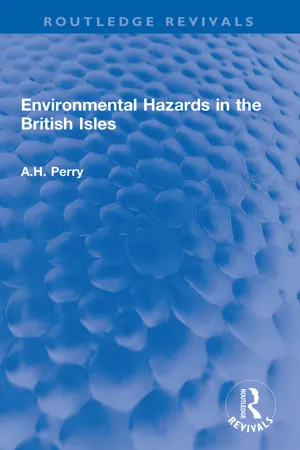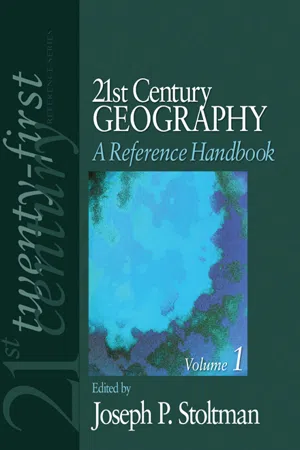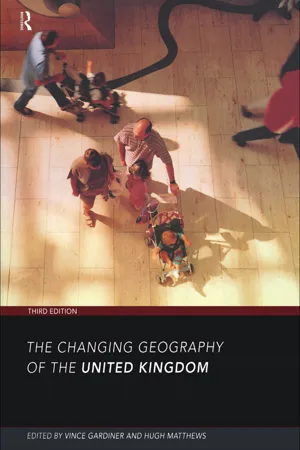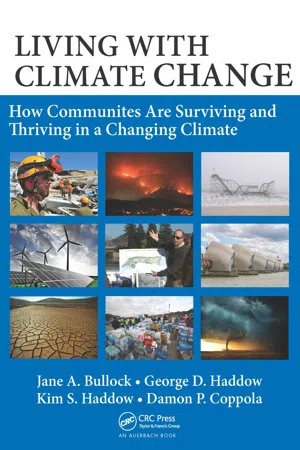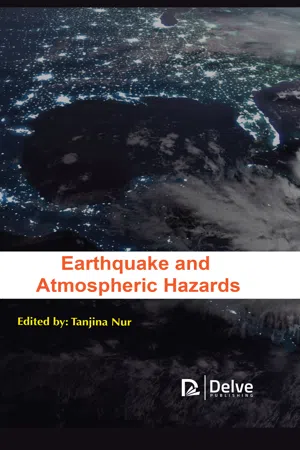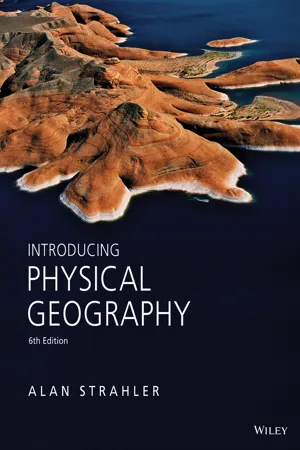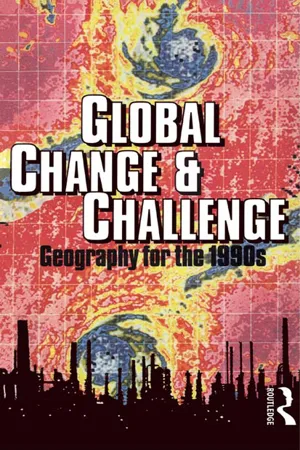Geography
Weather Hazards in the UK
The UK experiences a range of weather hazards, including storms, heavy rainfall, and flooding. Storms, such as those caused by low-pressure systems, can bring strong winds and heavy rain, leading to potential damage and disruption. The country's geography and proximity to the Atlantic Ocean make it particularly susceptible to these weather hazards.
Written by Perlego with AI-assistance
Related key terms
1 of 5
10 Key excerpts on "Weather Hazards in the UK"
- eBook - ePub
- A.H. Perry(Author)
- 2023(Publication Date)
- Routledge(Publisher)
Research into hazards in the British Isles has developed more recently, has been more fragmentary and diffused through a range of research groups than is the case in the USA. In particular, work on the magnitude, causes and frequencies of hazards has been undertaken by workers trained in the natural and physical sciences, while quite separately, studies of the management policies adopted to counteract the effect of different hazards has been analysed by social scientists. An attitude has lingered on that the British landscape is somehow protected by divine providence and moderate rainfall from calamities. Although some research papers, for example Balchin (1976), have examined the range of natural hazards experienced in the British Isles, no comprehensive synthesis of existing knowledge has been attempted hitherto. The British Isles are not immune to hazards because every parameter of the biosphere is subject to seasonal, annual or secular fluctuations, and constitutes a hazard to Man to the extent that his adjustments to the frequency, magnitude or timing of its extremes are based on imperfect knowledge. Hazard research has emerged as a recognisable subarea of geographical inquiry and an important element of the Man-environment relationship that is central to geographical studies. Stimulating opportunities exist for integrating established but divergent aspects of physical and human geography. Hewitt and Burton (1971) have recognised that the relationship between Man and his environment has its positive results (resources and commodities) and its negative results (hazards and damage). The variability and complexity in natural and human systems can make some phenomena, for example a river, both a hazard and a resource. Hazards have been defined by Gardiner (1977) as ‘events, objects, processes and substances that are perceived to cause more damage to, or impose more costs on, society than the benefits they give’ - Jonathan Rougier, Steve Sparks, Lisa J. Hill(Authors)
- 2013(Publication Date)
- Cambridge University Press(Publisher)
5 Risk and uncertainty in hydrometeorological hazards t. l. edwards and p. g. challenor 5.1 Introduction Extreme weather and ocean hazards are inescapable. Weather is the state of the atmosphere, to which every part of the earth’ s surface is exposed. In coastal regions and at sea there are equivalent oceanic hazards, such as extreme waves. Every region has a local normal range for atmospheric and oceanic, or ‘hydrometeorological’, conditions, around which societal decisions such as habitation and infrastructure are made. But inevitably there are fluctua- tions outside these bounds that result in hazard events. In general it is too difficult and costly to be fully prepared for the rare extremes. This chapter summarises the present-day risks and uncertainties associated with droughts, heat waves, extreme precipitation, wind storms and extreme ocean waves. How these may change under future climate change is discussed in Chapter 6. Other meteorological hazards, such as extreme cold, are not included here for reasons of space. Flooding and storm surge hazards are described separately in Chapter 7. Section 5.2 outlines the characteristics of the hazards. Section 5.3 discusses methods of assessing risks for hazards and their impacts. Section 5.4 describes organisations and tools of risk management and communication. Section 5.5 summarises. 5.2 Hydrometeorological hazards This section gives an overview of the hazards (definition, triggers and scale) and their associated losses (exposure and vulnerability; types and quantification of loss). 5.2.1 Definition The United Nations International Strategy for Disaster Reduction (http://www.unisdr.org) gives a general definition for a hydrometeorological hazard as a ‘process or phenomenon of atmospheric, hydrological or oceanographic nature that may cause loss of life, injury or other health impacts, property damage, loss of livelihoods and services, social and economic disruption, or environmental damage’.- eBook - PDF
- Joseph P. Stoltman(Author)
- 2011(Publication Date)
- SAGE Publications, Inc(Publisher)
Nevertheless, the anticipated recurrence of these events can be incorpo- rated into such maps to present the geophysical hazards of place (Cutter, 1996), based on past occurrences. Substantial progress is being made by the discipline of geography in identifying and analyzing the physical char- acteristics and mechanisms that lead to natural events and that, in tum, help create natural disasters. It is impossible to develop appropriate forecasting and warning systems, hazard alleviation measures, and mitigation strategies without such knowledge. However, there remains much to be researched. For instance, how well do our physically based models translate precipitation into stream flow in watersheds of different sizes and configurations? What additional data are needed to improve the models? How do different modes of delivery of precipitation such as tropi- cal cyclones, winter precipitation, squall line storms, and frontal rainfall translate into runoff, soil moisture, and flooding for different regional climates with different land cover patterns? And how will all of this be affected by climate change? As already noted, the physical environ- ment is both complex and dynamic, and there is a wide range of events that require continuing examination at numerous spatial and temporal scales. At the same time, human alteration of the geophysical environment cannot be ignored. Changes in land cover affect runoff and heat absorption, the former often increas- ing flood potential and magnitude and the latter exacerbat- ing heat waves. In the same vein, people building homes in remote areas, frequently referred to as the wildland-urban interface, that are naturally at risk to wildfires because of local and regional vegetation and climate characteristics, put themselves at risk, choosing to enjoy the benefits they perceive of such a location and minimizing or ignoring the Natural Hazards and Natural Disasters • 513 risks associated with the natural environment. - eBook - ePub
- Hugh Matthews, Vince Gardiner(Authors)
- 2002(Publication Date)
- Routledge(Publisher)
Hazard is an attribute that is definable as the propensity to cause harm, loss or adverse consequences. It is a human construct attributable to objects, substances, activities, processes or circumstances that result in harms, losses or costs to humans and what they value. Hazards are, therefore, defined by humans and not nature. They are cultural constructions and as human societies evolve and knowledge increases so too do the criteria for determining hazard and the range of phenomena that receive the label. As a consequence, hazard must be envisaged as a dynamic concept, in many regards similar to the concept of resource: indeed, Zimmerman’s famous statement about resources can be adapted to hazard to yield ‘hazards are not, they become’.Traditionally, three broad groups of hazard have been recognised, ‘social’, ‘technological’ and ‘natural’, with much of the geographical literature focusing on the so-called ‘natural hazards’ which can be defined as ‘those naturally occurring elements of the physical environment harmful to humans, human activity and the things that humans value’. Two broad categories are normally distinguished, geophysical and biological, which are capable of considerable further subdivision (e.g. atmospheric, geomorphological, floral, faunal, etc.). Attention on ‘natural hazards’ has been reinforced during the 1990s due to the United Nations proclaimed International Decade for Natural Disaster Reduction (IDNDR), which has sought to reduce the costs to global society arising from geophysical events (the so-called ‘natural tax’) by the international pooling of knowledge and expertise on how to mitigate adverse impacts.However, the validity of the fundamental threefold division of hazards has also come to be questioned as research has shown that many hazard events are surprisingly complex in the sense that they involve combinations of ‘social’, ‘technological’ and ‘natural’ elements. The basic ‘four phase’ model of hazard—Incubation-Trigger-Primary Hazard-Consequences— reveals that while the trigger event and primary hazard may be easily categorised into one of the three main groups (although not necessarily the same group), the incubation process and the resulting consequences (impacts, further hazards, benefits) often involve complex combinations. This is well illustrated by the nuclear fall-out from the Chernobyl nuclear accident (28 April 1986) which was the result of technological failure due to poor operating practices (social), with the adverse impacts on the sheep-rearing industry in Britain arising because the radioactive material had been transported by the wind and deposited by rain so as to produce a spatially variable pattern of contamination (Figure 17.1 - eBook - PDF
Living with Climate Change
How Communities Are Surviving and Thriving in a Changing Climate
- Jane A. Bullock, George D. Haddow, Kim S. Haddow, Damon P. Coppola(Authors)
- 2017(Publication Date)
- Auerbach Publications(Publisher)
This could include coastal flooding, riverine flooding, flash flooding, heavy snowfall, ava-lanche, mudslide, and drought. • Meteorological hazards are those that are related to atmospheric weather conditions. These hazards are the result of interactions between precipitation, temperature, wind speed, humidity, and other more complex drivers. Meteorological hazards include tropical cyclones, tornadoes, strong winds (including derechos, straight-line winds, and other vari-ants), ice storms, severe winter storms, hailstorms, frost, sandstorms, wildfires, thunder-storms, heat waves, extreme cold, and fog, to name a few. 18 17 16 15 14 13 12 11 10 9 8 7 6 5 4 3 2 1 0 18 17 16 15 14 13 12 11 10 9 8 7 6 5 4 3 2 1 0 1980 1982 1984 1986 1988 1990 1992 1994 1996 1998 2000 2002 2004 2006 2008 2010 2012 2014 Winter storm Wildfire Tropical cyclone Severe storm Freeze Flooding Drought Number of events Number of events FIGURE 2.2 Billion dollar weather and climate related disasters by year and hazard type. (From NOAA. 2014. Billion Dollar Weather/Climate Disasters: Time Series. NOAA National Climatic Data Center. Available at http://1.usa.gov/1BJgX3h.) 45 Community Risk Implications • Climatological hazards are related to meteorological hazards, but include the factor of time and relate to patterns. Climatological hazards include shifting annual average temperatures, long-term changes in precipitation, El Niño and La Niña, soil salination, desertification, soil and coastal erosion, and others (drought is often considered a climatological hazard). These three hazard groupings are just a subset of the larger category of natural hazards, which also includes tectonic hazards, mass-movement hazards, biological/health-related hazards, and other more obscure threats like meteors, animal attacks, and space weather. - Michael K. Lindell, Carla Prater, Ronald W. Perry(Authors)
- 2012(Publication Date)
- Wiley(Publisher)
The natural hazards are commonly categorized as meteorological, hydrological, or geophysical. ▲ Technological hazards originate in human-controlled processes but are released into the air and water. The most important technological hazards include explosives, flammable materials, toxic chemicals, radiological materials, and biological hazards. Some- times terrorists deliberately release technological hazards to meet political objec- tives. Whether a hazardous release is accidental or deliberate might make a dif- ference in the magnitude of the impact but not the types of impacts emergency managers must confront. You must know how to confront and deal with all types of hazards. This chapter discusses various types of hazards: meteorological, hydrologi- cal, geophysical, and technological. It also examines the risks and the effects and describes how to deal with them. As is the case with other emergencies, you must know how to work with others to deal with hazards. This chapter looks at how to do this when dealing with hazards. 5.1 Meteorological Hazards The main meteorological hazards are severe storms (including blizzards), severe summer weather, tornadoes, hurricanes, and wildfires. 5.1.1 Severe Storms The National Weather Service (NWS) defines a severe storm as one that has wind speeds exceeding 58 mph, that produces a tornado, or that releases hail with a diameter of three-quarters of an inch or greater. The threats from severe storms are: ▲ Lightning strikes ▲ Downbusts and microbursts ▲ Hail ▲ Flash floods Lightning can cause casualties. However, casualties are rare and are easily handled by local emergency medical services units. The bigger threat is that light- ning strikes can initiate wildfires that threaten entire communities. This is espe- cially true during droughts. Downbursts (up to 125 mph) and microbursts (up to 150 mph) are threats to aircraft as they take off or land. This creates a poten- tial for mass casualty incidents.- eBook - PDF
- Tanjina Nur(Author)
- 2019(Publication Date)
- Delve Publishing(Publisher)
49 References ............................................................................................... 54 Earthquake and Atmospheric Hazards 26 The climate system of the earth consists of variations in a multifaceted framework where the atmosphere of one region has an interaction with the atmosphere of the other regions. Other factors of this climate system include land, sea, ice, oceans, and its various other forms. In current years, extreme weather conditions are assumed to be caused by human led actions. Variations in any of the components of climatic system, whether it is introduced outside or inside the system, lead to changes in the climate of the earth. In the given chapter, the climate system and the ways to cope with severe weather events are discussed in detail. In later sections, the effects of changes in climate and natural hazards, types of natural hazards and the response of humans to these natural hazards are also highlighted. 2.1. INTRODUCTION Extreme weather conditions consist of unpredictable, unusual, unexpected, severe or sometimes unseasonal events. In current years, few extreme weather conditions are assumed to be caused by human led actions. Studies indicate a huge threat and danger from severe weather condition in the coming future. At times, when there is a severe weather event like drought or a flood, individuals often asks as to whether the condition was caused and led by worldwide warming. There is no straight answer for this question. Weather is always variable and severe weather conditions have always happened. Identifying the trends takes sufficient time, especially when there is a rarity in observational records or if it is even missing in few of the regions. A rise in extreme weather is assumed to be caused due to global warming as increase in temperature impact the parameters of weather in various ways. - eBook - PDF
Geomorphology and Natural Hazards
Proceedings of the 25th Binghamton Symposium in Geomorphology, Held September 24-25, 1994 at SUNY, Binghamton, USA
- M. Morisawa(Author)
- 2013(Publication Date)
- Elsevier Science(Publisher)
Some of these other hazards have been recently reviewed (e.g. Sherman and Nordstrom, 1994), whereas others, such as glacial movement or periglacial effects, are limited in their effect on human populations, or have received little attention as hazards. We have chosen to place geomorphology within the context of the original natural hazards paradigm (White, 1974a) for ease of discussion. We recognize the importance of socio-economic factors in creating hazardous conditions and point to this as an important area of future research. Ultimately, resolution of natural hazards problems must incorporate economics and society, and geomorphologists must be able to recog-nize how the natural systems are affected by human systems. In accordance with the first two goals of the natural hazards paradigm (White, 1974a), we contend that the physical aspects of a hazard event can be evaluated in terms of 5 components: (1) the dynamics of the phys-ical processes; (2) the prediction of the occurrence; (3) the determination of the spatial and temporal char-acteristics; (4) an understanding of the impact of phys-ical characteristics on people's perception; and (5) knowledge about how the physical aspects can be used to formulate adjustments to the event. 4.1. Soil erosion by water Unlike many natural disasters, there is no direct loss of life as a result of soil erosion, but it has a widespread distribution, high remediation costs, a potential for soil deterioration, and reduced food production. Evans (1990) shows that 36% of arable soils in England and Wales are at risk from moderate- to very high-erosion. An evaluation of costs associated with soil erosion in southern Ontario, Canada (Table 2) shows the degree to which the problem impinges on the human system. According to Wall and Dickinson (1978), total cost approached US$ 95 million in 1976; using the con-sumer price index, this cost is equivalent to about US$ 250 million in 1994 dollars. - eBook - PDF
- Alan H. Strahler(Author)
- 2013(Publication Date)
- Wiley(Publisher)
Are human activities increasing the frequency of these extreme events? As our planet warms in response to changes in the greenhouse effect, global climate modelers predict that weather extremes will become more severe and more frequent. Droughts and con- sequent wildfires and crop failures will happen more often, as will spells of rain and flood runoff. In the last decade, we have seen numerous examples of extreme weather events, from Hurricane Katrina in 2005—the most costly storm in U.S. history—to the devastating Texas drought of 2011–2012. Is human activity responsible for the increased occurrence of these extreme events? Significant evidence now points in that direction. Other extreme events, such as earthquakes, volcanic eruptions, and tsunamis, are produced by forces deep within the Earth that are not affected by human activity. But as the human population continues to expand and rely increasingly on a technological infrastructure, rang- ing from skyscrapers to the Internet, we are becoming more sensitive to damage and disruption caused by extreme events. This text describes many types of extreme events and their causes. In Chapters 4 and 6, we discuss thunderstorms, tornadoes, cyclonic storms, and hur- ricanes. Droughts in the African Sahel are presented in Chapter 7. Earthquakes, volcanic eruptions, and tsuna- mis are covered in Chapter 12. Floods are described in Chapter 14. Tools in Physical Geography Geographers use a number of specialized tools to exam- ine, explore, and interact with spatial data (Figure I.9). One of the oldest tools is the map, a representation of space showing where things are. While maps will never go out of style, computers have enhanced our ability to store, retrieve, and analyze spatial data through the development of the geographic information system ( GIS). - eBook - ePub
Global Change and Challenge
Geography for the 1990s
- Robert Bennett, Robert Estall(Authors)
- 2012(Publication Date)
- Routledge(Publisher)
2 ENVIRONMENTAL HAZARDS David K.C. Jones The natural environment cannot be considered as neutral, merely serving as a backcloth for human activity. In reality there are complex two-way interactions between human societies and the natural environmental systems (atmosphere, hydrosphere, lithosphere and biosphere) which vary over time and space. As human societies have evolved, so their appraisals of the natural environment have changed, but such evaluations essentially focus on three main categories of interaction: environmental constraints, resources and hazards. Environmental constraints (or biophysical limits) are met where the natural environment poses difficulties for human activity. Dense forests, swamps, steep mountains, aridity (in deserts) and harsh polar climates are examples of ‘inhospitable’ conditions. Such constraints can be overcome only through human organisation, technology and the heavy investment of labour and capital. There are innumerable examples of forest clearance, land drainage and slope modification which preceded contemporary activity. Such human interventions perhaps have their most dramatic modern manifestations in the irrigation schemes that have caused the deserts to bloom in parts of the United States, Libya and Israel. In Chapter 1 environmental resources were defined as attributes of the natural environment that are valued by human societies at any point in time. But those environmental events that cause ‘costs’ to society by inflicting death, destruction, damage or disruption are usually referred to as natural hazards or environmental hazards. It is essential to recognise that both ‘resources’ and ‘hazards’ are human assessments or cultural appraisals and are, as such, intimately interrelated. Few phenomena can be deemed wholly good or wholly bad, the vast majority are combinations of the two
Index pages curate the most relevant extracts from our library of academic textbooks. They’ve been created using an in-house natural language model (NLM), each adding context and meaning to key research topics.
